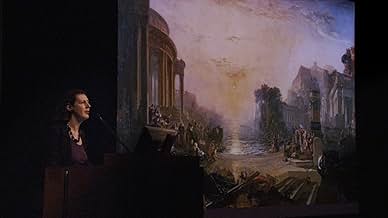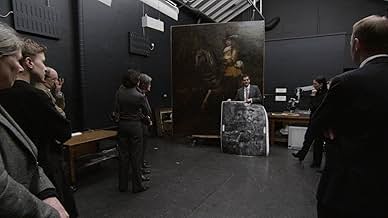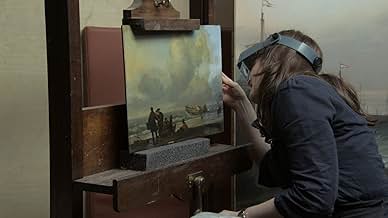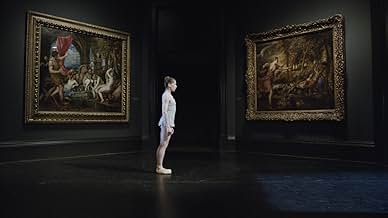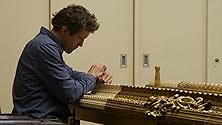CALIFICACIÓN DE IMDb
7.3/10
1.7 k
TU CALIFICACIÓN
Agrega una trama en tu idiomaA documentary that goes inside one of the great museums of the world: The National Gallery in London.A documentary that goes inside one of the great museums of the world: The National Gallery in London.A documentary that goes inside one of the great museums of the world: The National Gallery in London.
- Dirección
- Guionista
- Elenco
- Premios
- 1 premio ganado y 9 nominaciones en total
Nicholas Penny
- Self - director of the National Gallery
- (sin créditos)
Luke Syson
- Self - curator, National Gallery
- (sin créditos)
- Dirección
- Guionista
- Todo el elenco y el equipo
- Producción, taquilla y más en IMDbPro
Opiniones destacadas
Frederick Wiseman's new documentary NATIONAL GALLERY runs three hours; three hours of dissecting and analyzing the workings of one of the world's great Museums - the National Gallery in London England. Probing paintings' meaning and content; structure and design; the decisions involved in the way venerated and treasured works of art are conserved, restored, cleaned, lit and hung. We also are privy to the voices of the docents, curators, and staff talking about specific artworks connecting their audiences to the aesthetics, beauty, history, and science of conservation; the various pathways a painting takes from its original creation; its entry into various collections, and finally to its safe-keeping for posterity in the National Gallery Museum. We even listen to Nicholas Penny, the rumpled-haired Museum Director in a lecture taking a stab at Poussin - admitting that he is not sure if he likes the work, but is always intrigued by it.
Questions of elitism and exclusivity vs.accessibility and egalitarianism in light of budgetary considerations are discussed at meetings; there are lots of meetings. The film might have edited out some of the discussions - but I felt that the prosaic, the boring, the everyday-ness was worth observing. The running of a museum is not always glamorous. The decisions that establishments have to make in order to grip the public's interest - what lengths do they go to attract visitors, and at what price to their institution?
Wiseman just lets his camera roll; he never uses "voice overs". His working method and vitality at age 84 is unchanged - not intrusive - the filmmaker is always invisible - interviews are conducted by others. Frederick Wiseman lets us be the proverbial "fly on the wall" in a space that ordinarily would be bug-proof.
I loved watching one of the restorers discussing the cleaning of Velasquez' Christ in The House of Martha and Mary and passionately ponder the dilemma - do we over-strip the varnish used 100's of years ago and thereby brighten and change the artists' original intent? Ethical problems and compromises come into question. An in-house construction of a triptychs' impressive frame delicately carved by the crafts-men and women associated with the Museum, and the lighting of the finished piece held me spellbound, as did the issue of a cast shadow obscuring the top 1/4 of the painting once the work was installed. We also pay heed to restorers scraping away tiny slivers of paint with scalpels, Q-tips, eye-droppers, etc. and then put the minuscule paint shavings on a slide tray to be placed under a microscope to be scrutinized - to be thoroughly examined yielding a plethora of information; new scientific techniques today make this kind of investigation possible. We mark the fragility of time's passing on art realizing that there are effects that you have to live with, and guard against, but ultimately methodical and deductive technical intervention will be called upon to "save" the work from aging and deterioration.
The camera also takes us outside the Museum with aerial views of Trafalgar Square lit by the grays of daylight to the shimmering of the early darkness -focusing on the diverse community waiting patiently in the cold to to see the Da Vinci exhibition "Painter at the Court of Milan" (2012.) We are never far away from the human response to art - the intensity of the onlooker's gaze, the curiosity, confusion, delight, horror and interior peace that art can inculcate.
Other blockbusters such as "Turner Inspired by the light of Claude" and "Metamorphosis: Titian 2012" are exhibitions that we are fortunate to attend and hear curators/docents of varying sizes, ages and accents advocating for art's fascination and magnetism; confronting us with their disparate styles - some humorous, others psychoanalytical - all informative. Each artwork has a presence with an individual history and personal narrative imprinted on its essence - like life itself this movie is thrilling, enigmatic, complex and a singular jewel.
Questions of elitism and exclusivity vs.accessibility and egalitarianism in light of budgetary considerations are discussed at meetings; there are lots of meetings. The film might have edited out some of the discussions - but I felt that the prosaic, the boring, the everyday-ness was worth observing. The running of a museum is not always glamorous. The decisions that establishments have to make in order to grip the public's interest - what lengths do they go to attract visitors, and at what price to their institution?
Wiseman just lets his camera roll; he never uses "voice overs". His working method and vitality at age 84 is unchanged - not intrusive - the filmmaker is always invisible - interviews are conducted by others. Frederick Wiseman lets us be the proverbial "fly on the wall" in a space that ordinarily would be bug-proof.
I loved watching one of the restorers discussing the cleaning of Velasquez' Christ in The House of Martha and Mary and passionately ponder the dilemma - do we over-strip the varnish used 100's of years ago and thereby brighten and change the artists' original intent? Ethical problems and compromises come into question. An in-house construction of a triptychs' impressive frame delicately carved by the crafts-men and women associated with the Museum, and the lighting of the finished piece held me spellbound, as did the issue of a cast shadow obscuring the top 1/4 of the painting once the work was installed. We also pay heed to restorers scraping away tiny slivers of paint with scalpels, Q-tips, eye-droppers, etc. and then put the minuscule paint shavings on a slide tray to be placed under a microscope to be scrutinized - to be thoroughly examined yielding a plethora of information; new scientific techniques today make this kind of investigation possible. We mark the fragility of time's passing on art realizing that there are effects that you have to live with, and guard against, but ultimately methodical and deductive technical intervention will be called upon to "save" the work from aging and deterioration.
The camera also takes us outside the Museum with aerial views of Trafalgar Square lit by the grays of daylight to the shimmering of the early darkness -focusing on the diverse community waiting patiently in the cold to to see the Da Vinci exhibition "Painter at the Court of Milan" (2012.) We are never far away from the human response to art - the intensity of the onlooker's gaze, the curiosity, confusion, delight, horror and interior peace that art can inculcate.
Other blockbusters such as "Turner Inspired by the light of Claude" and "Metamorphosis: Titian 2012" are exhibitions that we are fortunate to attend and hear curators/docents of varying sizes, ages and accents advocating for art's fascination and magnetism; confronting us with their disparate styles - some humorous, others psychoanalytical - all informative. Each artwork has a presence with an individual history and personal narrative imprinted on its essence - like life itself this movie is thrilling, enigmatic, complex and a singular jewel.
For those who enjoy the experience of visiting art museums, National Gallery' is a must-see. The brilliant objectivist documentarian Frederick Wiseman captures the iconic British museum from every side imaginable. Over the course of three hours, he offers a grand glimpse of the museum's collection and temporary exhibits as others look or discuss them, from art historians to tour guides. Fixed history and interpretation are celebrated in both Wiseman's camera and the loosely strung scenes of people in the exhibition halls. The movie cuts to various perspectives of the museum, from details of paintings to entire galleries, as people gaze at works. But Wiseman also captures the people operating the museums during PR and budget meetings and, most intriguingly, at work restoring paintings. No one looks at the camera to explain their work and Wiseman never even uses superimposed title cards, yet you will come away enlightened.
If you are familiar with Wiseman's work, you know that he is a true documentarian. No Michael Moore-type bias, no opinions, just a pure document for you to do with what you will. I enjoyed every minute and learned much about the day-to-day life in London's National Gallery. I loved the staff lectures on different paintings, the restoration sections were fascinating, and even the board meetings were interesting (even though I hate meetings in real life LOL).
I'm only sorry Frederick Wiseman is getting older and cannot be with us for another 80 years so he can make even more documentaries. Brilliant, beautiful, sublime .
I'm only sorry Frederick Wiseman is getting older and cannot be with us for another 80 years so he can make even more documentaries. Brilliant, beautiful, sublime .
National Gallery (2014) was directed by Frederick Wiseman. Wiseman is also listed as writer, co-producer, and editor. Although this is obviously very much a Wiseman film, Wiseman himself never appears in it.
This is typical of Wiseman. He finds ways to go where no other cinematographer could go, and he films what he sees. Moreover, there's never a hint that people are aware of the camera's presence, and there's no voice-over. What he sees is what you get. There's no explanations and no talking heads.
Because National Gallery is about a major art gallery, this film doesn't have the sizzle and pop that occur in some of Wiseman's other documentaries. For example, Astoria (2000) is about a multi-ethnic neighborhood in Queens, NY. Naturally it's more lively and inherently more interesting than National Gallery.
However, Wiseman is a great director, and he makes a relatively quiet art gallery a place where we see quiet internal struggles, and some great discussions of the paintings themselves, and the technical aspect of restoring paintings and even of making frames.
I was very interested in the board room scenes. It became clear to me that there was a subsurface struggle between the director and most of his staff. The staff wanted to make the museum more user-friendly. For example, the U.S. National Gallery and the Metropolitan Museum in NYC are user-friendly. People from all the strata of society feel comfortable there. From context, that isn't so at the National Gallery.
The staff would like to change that, but it becomes apparent that the director is looking for middle- and upper-class attendance. If Bill Rugby doesn't feel at home at the museum, the director doesn't really care.
Nobody on the staff wants to confront him directly, so they keep agreeing with him, and then saying, "Yes, but . . . " He ignores these oblique suggestions, and he prevails.
The movie is three hours long, and there are many segments. Some segments worked really well, but some of the segments didn't work for me at all. For example, there's a special program at the gallery for visually impaired people. A lecturer has a work of art, and describes it in terms of lines and angles. The visually impaired people are supposed to "see" the painting in this way. It didn't look like any of them could, indeed, visualize the painting. And, unfortunately, this scene went on and on. It's a three-hour movie, so Wiseman could allow this scene to go on and on, but it wasn't enjoyable for me.
This isn't a movie that you should watch for excitement and revelation. On the other hand, if you love art, and art museums, it's the movie for you.
We saw National Gallery on DVD. It worked very well on the small screen.
This is typical of Wiseman. He finds ways to go where no other cinematographer could go, and he films what he sees. Moreover, there's never a hint that people are aware of the camera's presence, and there's no voice-over. What he sees is what you get. There's no explanations and no talking heads.
Because National Gallery is about a major art gallery, this film doesn't have the sizzle and pop that occur in some of Wiseman's other documentaries. For example, Astoria (2000) is about a multi-ethnic neighborhood in Queens, NY. Naturally it's more lively and inherently more interesting than National Gallery.
However, Wiseman is a great director, and he makes a relatively quiet art gallery a place where we see quiet internal struggles, and some great discussions of the paintings themselves, and the technical aspect of restoring paintings and even of making frames.
I was very interested in the board room scenes. It became clear to me that there was a subsurface struggle between the director and most of his staff. The staff wanted to make the museum more user-friendly. For example, the U.S. National Gallery and the Metropolitan Museum in NYC are user-friendly. People from all the strata of society feel comfortable there. From context, that isn't so at the National Gallery.
The staff would like to change that, but it becomes apparent that the director is looking for middle- and upper-class attendance. If Bill Rugby doesn't feel at home at the museum, the director doesn't really care.
Nobody on the staff wants to confront him directly, so they keep agreeing with him, and then saying, "Yes, but . . . " He ignores these oblique suggestions, and he prevails.
The movie is three hours long, and there are many segments. Some segments worked really well, but some of the segments didn't work for me at all. For example, there's a special program at the gallery for visually impaired people. A lecturer has a work of art, and describes it in terms of lines and angles. The visually impaired people are supposed to "see" the painting in this way. It didn't look like any of them could, indeed, visualize the painting. And, unfortunately, this scene went on and on. It's a three-hour movie, so Wiseman could allow this scene to go on and on, but it wasn't enjoyable for me.
This isn't a movie that you should watch for excitement and revelation. On the other hand, if you love art, and art museums, it's the movie for you.
We saw National Gallery on DVD. It worked very well on the small screen.
A wonderful documentary of the National Gallery, a great museum in London and one of the greatest in the world with a large collection of masterpieces dated back from 16th century. This documentary makes it a living museum through the exhibition of several paintings, the galleries and the public around them. There are several explanatary commentaries by the museum technicians about the paintings and some talks also about the museum direction and planning all with excellent quality and remarkable detail. Indeed one of the best movies of 2014.
¿Sabías que…?
- ConexionesReferenced in Film Junk Podcast: Episode 493: Predestination (2014)
- Bandas sonorasSonate pour piano Op. 31 no 3
Music by Ludwig van Beethoven
Performed by Kausikan Rajeshkumar, RCM
dans la cadre de Belle Shenkamn Music Program (correct is "Belle Shenkman music programme")
[Récital]
Selecciones populares
Inicia sesión para calificar y agrega a la lista de videos para obtener recomendaciones personalizadas
- How long is National Gallery?Con tecnología de Alexa
Detalles
- Fecha de lanzamiento
- Países de origen
- Sitio oficial
- Idioma
- También se conoce como
- 歡迎光臨國家畫廊
- Locaciones de filmación
- Productoras
- Ver más créditos de la compañía en IMDbPro
Taquilla
- Total en EE. UU. y Canadá
- USD 253,941
- Fin de semana de estreno en EE. UU. y Canadá
- USD 10,049
- 9 nov 2014
- Total a nivel mundial
- USD 354,971
- Tiempo de ejecución3 horas
- Color
- Relación de aspecto
- 1.85 : 1
Contribuir a esta página
Sugiere una edición o agrega el contenido que falta

Principales brechas de datos
By what name was National Gallery (2014) officially released in Canada in English?
Responda






